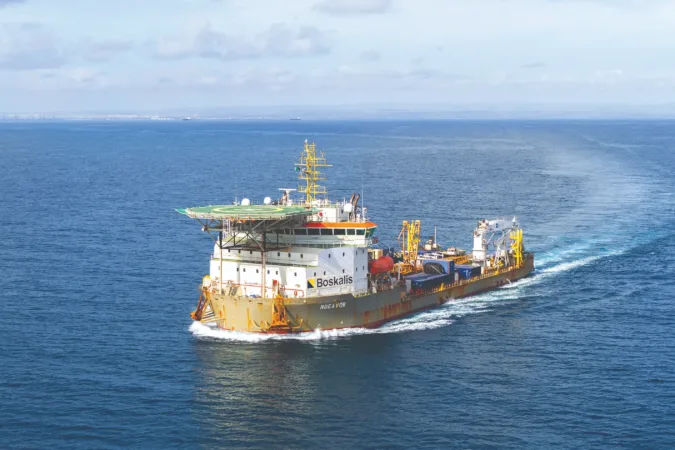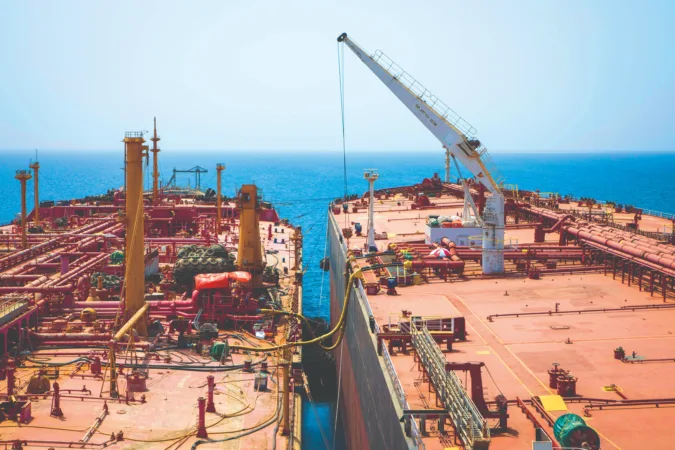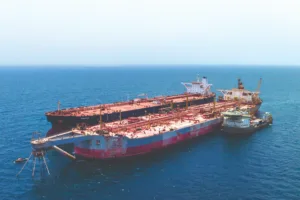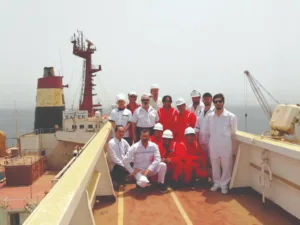FSO Safer was constructed in 1976 as a ULCC under the name Esso Japan. It was converted a decade later into a floating storage and offloading (FSO) facility for crude oil and renamed after its new owner, the Safer Exploration & Production Operation Company (SEPOC) – Yemen’s national oil company, which in turn is named after the location of the country’s first crude oil reserve discovery outside Marib at Safar (also spelt “Safer”). Unfortunately, after years of neglect, FSO Safer no longer lived up to the alternative interpretation of its name.
Moored 4.8 NM off the west coast of Yemen in the Red Sea, FSO Safer was holding an estimated 150,000 MT (1.14 million barrels) of crude oil when production, export operations, and maintenance were suspended in 2015 due to the country’s escalating civil war, leaving it to fall into a state of disrepair and compromised integrity. Over time, neglected corrosion, the build-up of flammable gases, and other risk factors had turned the vessel into a ticking time bomb, risking an oil spill four times the size of the 1989 Exxon Valdez disaster.
Given the potential for such a large-scale environmental catastrophe and the urgency of the situation, the United Nations stepped in to take the lead in organising a preemptive salvage operation. Initial discussions commenced in 2019, culminating in a memorandum of understanding between relevant parties in 2022, with the United Nations Development Programme (UNDP) tasked with implementing the agreed two-phase project.
The top and utmost priority was to eliminate the immediate danger of an oil spill. The plan was to transfer the oil to a replacement vessel and to prepare FSO Safer for towing. Boskalis – via its subsidiary SMIT Salvage and cable-laying vessel MV Ndeavor – played a pivotal role in phase one, tasked with inspections, eliminating hazards, and providing offshore support.
Phase two revolved around establishing a safe, long-term solution to substitute the existing arrangement with FSO Safer. This would involve the installation of a catenary anchor leg mooring (CALM) buoy to which the replacement vessel could be securely connected, while towing FSO Safer to a green salvage yard for safe cleaning, recycling, and the responsible disposal of parts.
Key to both phases of the project was the identification of a suitable replacement vessel. As it so happened, that vessel turned out to be MT Nautica, a 2008-built VLCC owned by Euronav and managed by Anglo-Eastern.
THE COST OF INACTION IF FSO SAFER HAD LEAKED
- USD 20 billion just to clean-up the oil spill alone
- Extensive damage to Red Sea ecosystems and biodiversity
- 25 years for fish stocks to recover
- USD 1.5 billion economic cost to Yemeni fisheries during this period
- Closure of ports in the area and the economic and humanitarian costs this would entail
- Extended disruption to vital shipping lanes to the Suez Canal, which would cost billions of dollars per day to the world economy
- In the event of the oil catching fire, 8.4 million people exposed to harmful levels of pollutants
FROM NAUTICA TO YEMEN

The Nautica team was first notified that the tanker would be involved in a special ship-to-ship (STS) project and needed to be converted into a moored oil storage tanker (MOST) in January this year. Routine dry-docking was planned in March, so the required modifications could be tagged on then. These included the installation of an emergency hook release mechanism, a reverse osmosis plant, new electrical heaters in the engine room for the fuel and lube oil, and a CCTV system for security purposes.
While in dry-dock overseeing the modifications, the team was further informed that Nautica would no longer be a Euronav-owned vessel, as it would be acquired by the United Nations – or the UNDP, to be precise – and would be sailing to Yemen, where it would be making international headlines as part of the FSO Safer salvage operations, which was already on the radar of many media outlets and environmental groups. Not your everyday briefing, that’s for sure!
But first, Nautica needed to call on Singapore to pick up the STS equipment, load up on provisions and stores, and perform a full crew change. While en route, the vessel’s tanks were inerted in preparation for the looming task ahead. The next stop was Djibouti, where the tanker and its crew remained for ten weeks for planning and preparations with the SMIT Salvage team.
Finally, on July 17, Nautica dropped anchor off the Ras Isa peninsula, where FSO Safer was then moored, and was officially renamed Yemen following the formal conclusion of the sale. Euronav would now act as ship manager, with Anglo-Eastern as the subcontracted technical manager.
PHASE ONE BEGINS

With the help of Ndeavor, MOST Yemen, under the leadership of Anglo-Eastern’s Capt. Raul Baluteanu and C/E Mihai Roata, was brought alongside FSO Safer. Our mixed Romanian, Georgian and Filipino crew on board were soon joined by an even more international team comprising members of the United Nations, SMIT Salvage, and local authorities to discuss and finalise plans for the STS operation, with a UNDP official serving as project coordinator.
A thorough inspection of FSO Safer was conducted by SMIT Salvage’s team of experts, who were also responsible for eliminating hazards on board and preparing the vessel for both STS and salvage operations. This involved putting in place measures to prevent fire and leakages, restoring essential systems like lighting, overhauling the required valves and infrastructure for the STS operations, lowering portable hydraulic cargo pumps into the vessel’s tanks, and for both sides to connect their respective cargo hoses and vapour return lines between the two vessels.
As an added precaution in case of any oil spill, containment booms were put around the two vessels, while an aircraft loaded with oil spill dispersant and other similarly equipped vessels remained on standby nearby to provide assistance.
With everything in place, it was now time for action! STS operations commenced the morning of July 25th, with oil being pumped from FSO Safer to MOST Yemen. Transferring the equivalent of 1.14 million barrels of crude oil from one vessel to another by a single cargo hose was never going to be a fast process. Altogether it took two-and-a-half weeks of continuous pumping, with the transfer safely and successfully completed on August 11th, much to everyone’s relief and elation.
SHAPING A BETTER MARITIME FUTURE
With the imminent danger posed by the decaying FSO Safer removed, we have collectively been able to avert what could have been one of the world’s worst oil spills in over a decade. There is still much to be done, however, from responsibly cleaning and retiring the vessel and transferring the tank wash waste to MOST Yemen to overseeing the latter’s handover and training of the new Yemeni crew, which our staff on board will be managing in the coming weeks. But with FSO Safer now safe again from the risk of a catastrophic oil spill, we can all breathe a sigh of relief that the worst of the situation is over.
Well done and congratulations to everyone involved in this truly global effort, in particular our partners, Boskalis and Euronav, as well as our crew members on board Nautica/ Yemen and the Anglo-Eastern Tanker Management team in Hong Kong who supported them throughout, notably deputy fleet manager Rahul Balani.
Saving our oceans is a very noble and necessary cause, and we are proud to have been involved in this project along with our partners. Shaping a better maritime future together doesn’t get more real than this!











